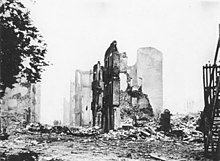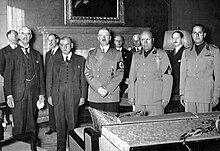Invasion of Ethiopia
The Second Italo–Abyssinian War was a brief colonial war that began in October 1935 and ended in May 1936. The war was fought between the armed forces of the Kingdom of Italy (Regno d'Italia) and the armed forces of the Ethiopian Empire (also known as Abyssinia). The war resulted in the military occupation of Ethiopia and its annexation into the newly created colony of Italian East Africa (Africa Orientale Italiana, or AOI); in addition, it exposed the weakness of the League of Nations as a force to preserve peace. Both Italy and Ethiopia were member nations, but the League did nothing when the former clearly violated the League's own Article X.
Spanish Civil War
Germany and Italy lent support to the Nationalist insurrection led by general Francisco Franco in Spain. The Soviet Union supported the existing government, the Spanish Republic which showed leftist tendencies. Both sides used this war as an opportunity to test improved weapons and tactics. The Bombing of Guernica, a city of 5000 - 7000 inhabitants, was considered a horrifying attack at the time, with a propaganda figure of 1,654 people killed widely circulated in the west, leading to charges of "terror bombing". In reality the attack was tactical operation against a city with militarily important communications close to the front-line, and modern estimates yield no more than 300 - 400 dead at the high-end.
Japanese invasion of China
In July 1937, Japan captured the former Chinese imperial capital of Beiping after instigating the Marco Polo Bridge Incident, which culminated in the Japanese campaign to invade all of China. The Soviets quickly signed a non-aggression pact with China to lend materiel support, effectively ending China's prior cooperation with Germany. Generalissimo Chiang Kai-shek deployed his best army to defend Shanghai, but after three months of fighting, Shanghai fell. The Japanese continued to push the Chinese forces back, capturing the capital Nanjing in December 1937 and committed the Nanking Massacre.
In June 1938, Chinese forces stalled the Japanese advance by flooding the Yellow River; although this manoeuvre bought time for the Chinese to prepare their defences atWuhan, the city was taken by October. Japanese military victories, however, did not bring about the collapse of Chinese resistance that Japan had hoped to achieve, instead the Chinese government relocated inland to Chongqing to continue their resistance.
Japanese invasion of the Soviet Union and Mongolia
On 29 July 1938, the Japanese invaded the USSR and were checked at the Battle of Lake Khasan. Although the battle was a Soviet victory, the Japanese dismissed it as an inconclusive draw, and on 11 May 1939 decided to move the Japanese-Mongolian border up to the Khalkhin Gol River by force. After initial successes the Japanese assault on Mongolia was checked by the Red Army that inflicted the first major defeat on the Japanese Kwantung Army.
These clashes convinced some factions in the Japanese government that they should focus on conciliating the Soviet government to avoid interference in the war against China and instead turn their military attention southward, towards the US and European holdings in the Pacific, and also prevented the sacking of experienced Soviet military leaders such as Georgy Zhukov, who would later play a vital role in the defence of Moscow.
European occupations and agreements
In Europe, Germany and Italy were becoming bolder. In March 1938, Germany annexed Austria, again provoking little response from other European powers.Encouraged, Hitler began pressing German claims on the Sudetenland, an area of Czechoslovakia with a predominantly ethnic German population; and soon France and Britain conceded this territory to him, against the wishes of the Czechoslovak government, in exchange for a promise of no further territorial demands. Soon after that, however, Germany and Italy forced Czechoslovakia to cede additional territory to Hungary and Poland. In March 1939, Germany invaded the remainder of Czechoslovakia and subsequently split it into the German Protectorate of Bohemia and Moravia and the pro-German client state, the Slovak Republic.
Alarmed, and with Hitler making further demands on Danzig, France and Britain guaranteed their support for Polish independence; when Italy conquered Albania in April 1939, the same guarantee was extended to Romania and Greece. Shortly after the Franco-British pledge to Poland, Germany and Italy formalised their own alliance with the Pact of Steel.
In August 1939, Germany and the Soviet Union signed the Molotov–Ribbentrop Pact, a non-aggression treaty with a secret protocol. The parties gave each other rights, "in the event of a territorial and political rearrangement," to "spheres of influence" (western Poland and Lithuania for Germany, and eastern Poland, Finland, Estonia, Latvia and Bessarabia for the USSR). It also raised the question of continuing Polish independence.




No comments:
Post a Comment